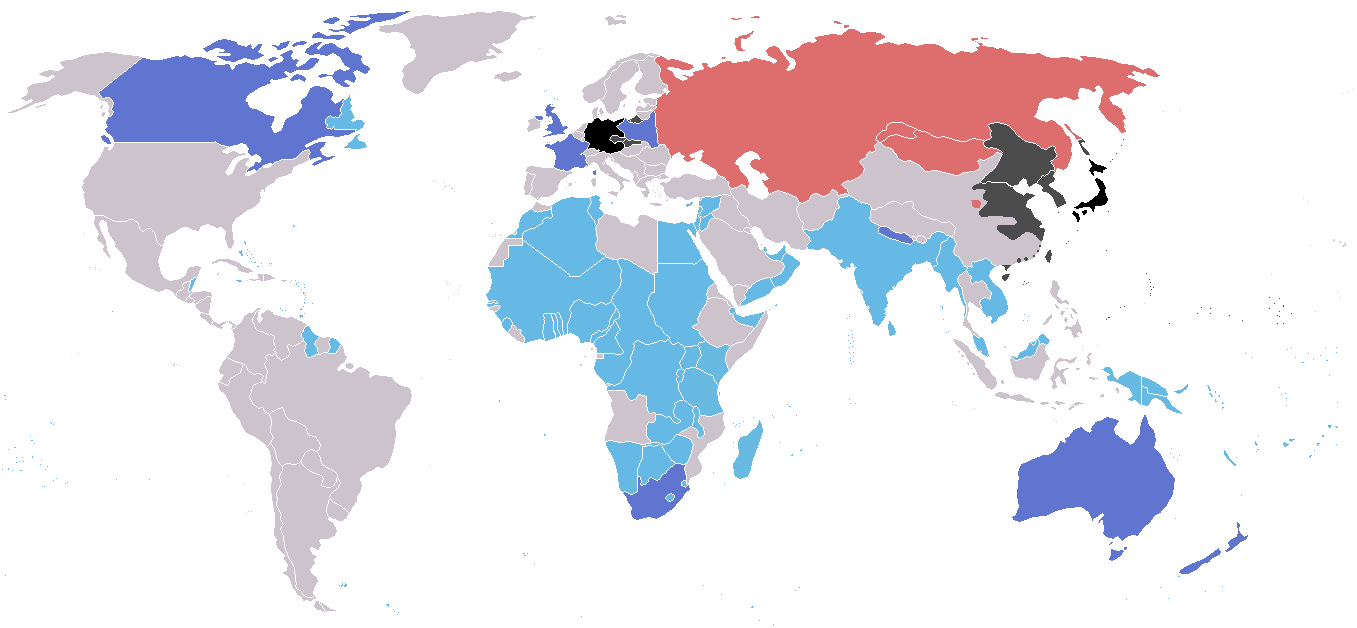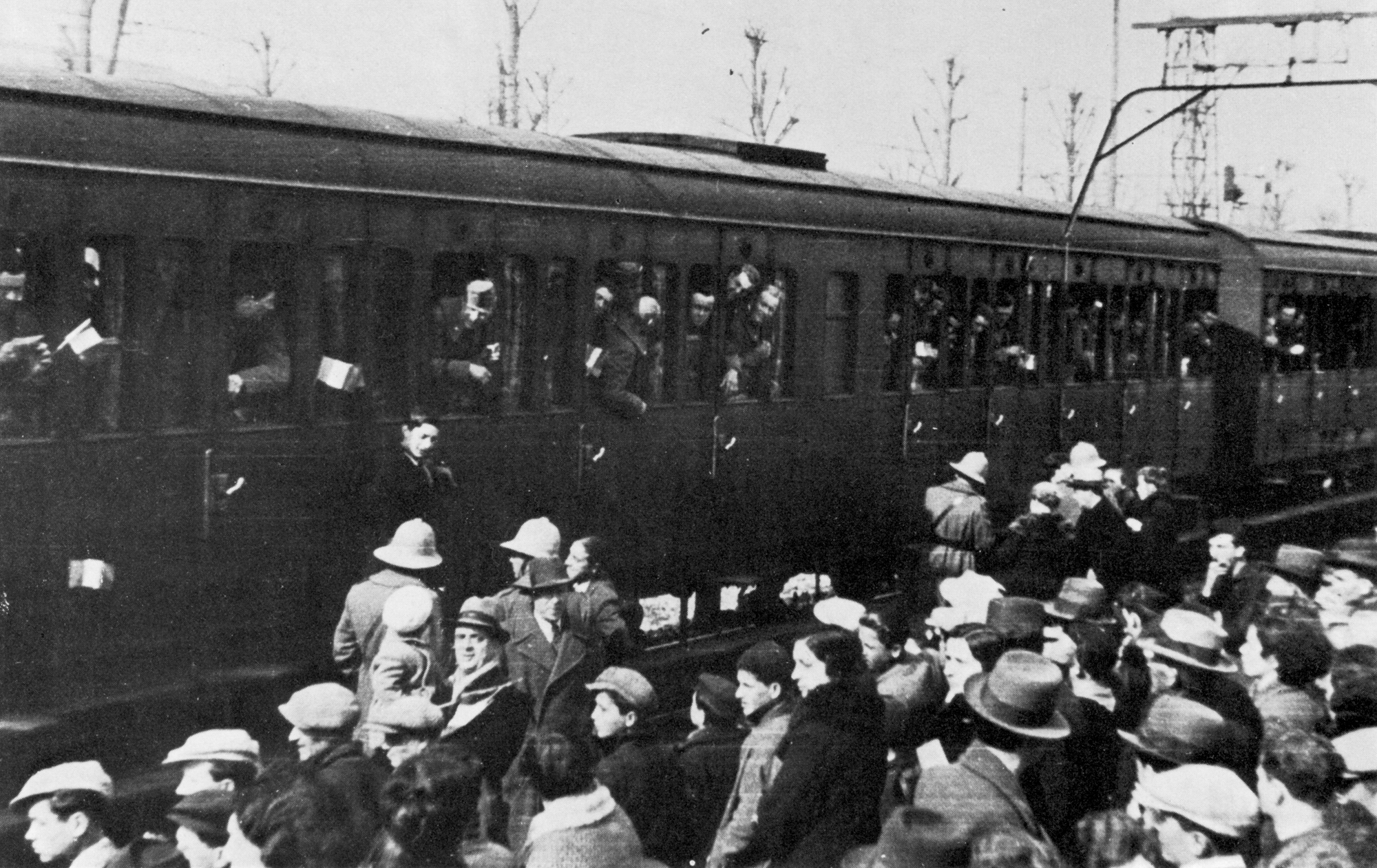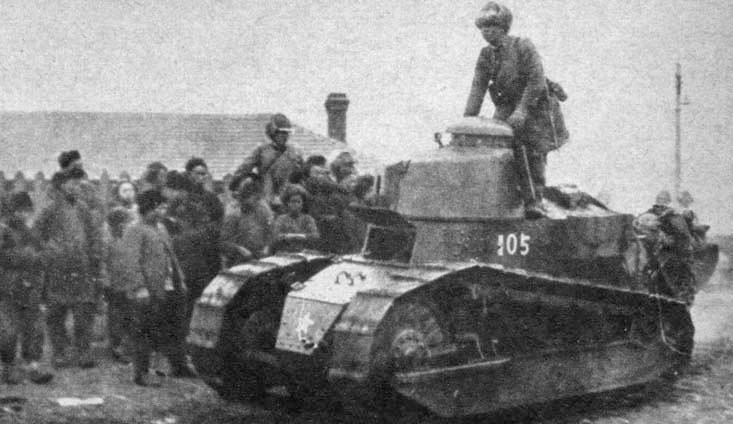Topics on the Page
-
Overview of Drives for Empire
-
Italy’s invasion of Ethiopia in 1935
-
The Japanese invasion of China and the Rape of Nanking
-
Germany’s militarization of the Rhineland, annexation of Austria, and aggression against Czechoslovakia, the Stalin-Hitler Pact of 1939, and the German attack on Poland
-
Role of Women in Nazi Germany and Fascist Societies
 |
| Alliances during WWII, September 1939. Dark Blue: Western Allies Countries; Light Blue: Western Allies Colonies; Pink: Eastern Allies; Black: Axis Countries; Dark Gray: Axis Colonies; Light Gray: Neutral |
Focus Question: What were the motivations for the German, Italian and Japanese drives for empire in the 1930s?
Overview of Drives for Empire
Germany and Italy had both experienced national embarrassment and economic depression in the aftermath of World War I and during the Great Depression.
- Both these nations were controlled by charismatic leaders with visions of empire:
- for Mussolini, the goal was a rebirth of the Roman Empire.
- For Hitler, this empire was based on his ideology of a "master race" of German-speakers with Nordic blood.
- Japan too was experiencing the fallout of the Great Depression, and it needed natural resources to maintain its new modern status as an industrialized manufacturing nation.
- Japan envisioned a unified bloc of Asian countries with which to control the Asian markets and keep out the Western powers, and sought empire for this reason.
Major motivations for empire building in Italy, Germany and Japan were:
-
Improvement of economic conditions and positioning
-
Territorial expansion
-
Military strengthening
-
Possession of natural resources
-
National pride
 A lesson plan on the rise of dictators.
A lesson plan on the rise of dictators.

Italy's invasion of Ethiopia in 1935
 |
| Italian Soldiers Recruited to Fight, 1935 |
The dictator of Italy, Benito Mussolini wanted to expand his empire. Italy had lagged behind in the Industrial Revolution and lacked its own natural resources, while Ethiopia had an abundance.
- The invasion of Ethiopia was also a matter of national pride. Italy had experienced an embarrassing defeat at the hands of the Ethiopians in the First Italo-Abyssian War,which left Ethiopia as one of only two African nations to resist European colonization and remain independent.
- On October 3, 1935, Italian forces invaded poorly-armed Ethiopia without a declaration of war. By October 15, the Italians had taken the holy capital, Axum. In the brief war that followed, known as the Second Italo-Abyssian War (Oct 1935-May 1936), the Italians poisoned the water supply and used mustard gas, prohibited by the Geneva Protocol.
- By June 1936, Italy developed a constitution claiming Ethiopia as part of an administrative unit linked with its two neighboring colonies: Italian East Africa.
- The invasion of Ethiopia was pivotal in demonstrating the ineffectiveness of the League of Nations.After the invasion, the League declared Italy the aggressor but did not take any real steps to control Italy or protect Ethiopia. Mild sanctions were imposed, but they were largely ineffective and ignored by Mussolini.
This link and this link are newsreels of the Ethiopian invasion from when it occurred.
Click here for more information about the Ethiopian invasion.
Click here for a brief educational video on the Italian Army.
A report about women's role in the Ethiopian military. Look at page 21 for specific information about the conflict with Italy.
A detailed report on Women's roles in Fascist Italy
Click here for a lesson plan for Germany, Italy, and Japan's aggression prior to WWII, which also discusses the rise of Fascism in these countries
The Japanese invasion of China and the Rape of Nanking
 |
| Japanese Renault tank in Manchuria, 1931 |
Link to Dramatic Event page on the Rape of Nanking
See also World History II-14 for information on major developments in Japanese history in the 19th and early 20th centuries
Dating back to the Meiji restoration and modernization, Japan wanted to expand their empire and be recognized as a power in the Western World.
- In the First Sino-Japanese War against China, Japan defeated China with Western military tactics and ships to gain control of Korea.
- They later defeated Russia in the Russo-Japanese war strengthening the military's resolve and showing that they could beat a Western power.
- After World War I ended, Japan used the weakness of some European nations to grab resources from countries they had previously colonized.
- With the Great Depression, over-populated Japan experienced a severe shortage of natural resources, and looked to China.
Japan first invaded Manchuria (a large region in Northeast China) in 1931, feeling that it needed raw materials and more space for its increasing population.
Japan would justify its expansion with the idea of a united Asian continent, called the Greater East Asian Co-Prosperity Sphere.
It continued conquest into the Jehol province of China until it ultimately launched a full-scale occupation in July 1937, an offensive also known as the Second Sino-Japanese War.
China's most important port, Shanghai, fell in November of the same year. Then in December, Nanjing (Nanking), Chiang-Kai-shek's capital, fell to the Japanese. During the taking of the city, Chinese Citizens were brutally raped and murdered by Japanese Soldiers in what would become know as the Rape of Nanking. For more on the brutal events of the invasion click here.
Click here for an article discussing why Japan chose to go to war
Click here for a YouTube video discussing Japan's aggression prior to WWII
Germany's militarization of the Rhineland, annexation of Austria, and aggression against Czechoslovakia, the Stalin-Hitler Pact of 1939, and the German attack on Poland
Like Italy and Japan, German aggression came from a need for resources, a desire to expand or gain back former land, and extreme nationalism. Additionally, Germany under the rule of Hitler and the Nazis believed in an ideology of racial superiority, that the Aryan race was destined to rule and flourish. This meant the presence of other races in nearby provinces posed a threat to their expansion and empire.
Hitler's Mein Kampf, which details his political ideology and theories on the "Jewish peril."
After World War I and the Treaty of Versailles, Germany was restricted to keep its armed forces under 100,000 troops. In 1935, with very nationalistic principles, Hitler began to build Germany's empire. The Treaty of Versailles demilitarized an area of Germany known as the Rhineland, which was the heart of Germany's industry, in order to place a buffer between it and France. In 1936, German troops crossed the border and militarized the Rhineland, movement which was generally ignored by Britain and France in a policy known as "appeasement."
In 1938, again in direct defiance of the Treaty of Versailles, Hitler annexed Austria, a German-speaking nation rich in natural resources. Known as the Anschluss, the union was generally welcomed by the Austrians, and again ignored by the rest of Britain and the rest of Europe.
Empowered by this movement, Hitler then sought a takeover of Sudetenland, a region in Czechoslovakia dominated by Germans. Hitler claimed that that Germans were being suppressed by the Czechs, and demanded annexation of the region.
In another act of appeasement, Hitler was granted his request through the Munich Agreement, an agreement in which the Czech government had little say. Shortly thereafter, Hitler annexed the rest of Czechoslovakia.
For more background, see The Munich Agreement, a video from the History Lessons series of the Council on Foreign Relations,
By 1939, Germany had the second largest army in the world in direct violation of the Treaty of Versailles.
"Wonder how long the honeymoon will last?" Clifford Berryman. The Washington Star. 1939

The Stalin-Hitler Pact
The Stalin-Hitler Pact of 1939 (aka the treaty of non-aggression, the Molotov-Ribbentrop Pact) consisted of an agreement that the two countries would not be aggressive with each other.
It also included a secret protocol that divided several countries -- Finland, Estonia, Latvia, Lithuania, Poland, and Romania -- into Nazi/Soviet territories.
For a detailed video of a time lapse of Europe and territorial expansion during WWII, Click here.
The Stalin-Hitler Pact directly led to World War II, as it allowed Hitler to launch an attack on Poland without having to fight the Soviets. The pact remained in effect until Hitler broke the agreement by invading the Soviet Union in 1941.
Full text of the Stalin-Hitler Pact of 1939
The German invasion of Poland and subsequent declarations of war on Germany by Britain and France is considered the beginning of World War II. After the Germans attacked from the west, the Soviets attacked from the east as per their agreement. Poland lost 20% of its population and 90% of its Jewish population during German occupation [2].

Materials and lesson plans for a World War II Jeopardy! game

Documentary On the Rise of the Third Reich by the History Channel
Click here for a timeline of German aggression prior to WWII
Click here for a Khan Academy video discussing Nazi aggression and appeasement prior to WWII
Click here for an interactive map detailing various acts of aggression by Germany, Italy, and Japan before and during WWII
Women's Roles in Nazi Germany and Fascist Societies
See, Role of Women in Nazi Germany from The Holocaust Explained, London Jewish Cultural Centre.
Women in the Third Reich from the United States Holocaust Museum
Sexualized Violence directed against women both before and during the Holocaust
Click here for women's roles in the German growing Dictator empire.
Click here for an article discussing Japanese women's wartime contributions on the home front
Click here for an article discussing the efforts of Italian women forming a resistance following Benito Mussolini's downfall
Websites/Sources
[1] http://www.ibiblio.org/hyperwar/PTO/IMTFE/IMTFE-8.html
[2] http://www.expatica.com/de/news/german-news/Polish-experts-lower-nation_s-WWII-death-toll--_55843.html
[3] http://www.historyplace.com/worldhistory/genocide/nanking.htm
http://www.onwar.com/aced/nation/ink/italy/fitalyethiopia1935.htm
http://www.historylearningsite.co.uk/china_war.htm
http://vlib.iue.it/history/mil/ww2.html
The event in which Japanese troops committed mass rape and murder against Chinese civilians is known as
A. My Lai Massacre
B. Nanking Massacre
C. Changjiao Massacre
D. Tinta Massacre
Answer: B
Comments (0)
You don't have permission to comment on this page.